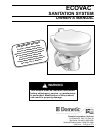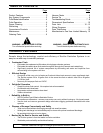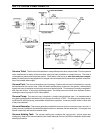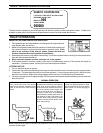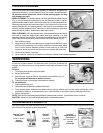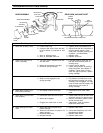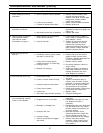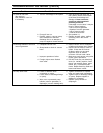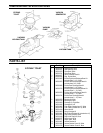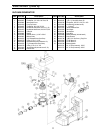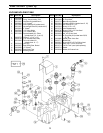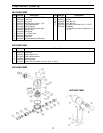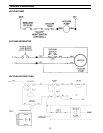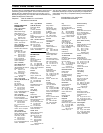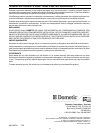
8
7. Water leaking from rear of
toilet bowl.
8. Water is leaking from the
base/toilet connection.
9. Vacuum pump running too
often between flushes.
(See Vacuum Tester
Information on page 6.)
10.Vacuum pump will not
shut off.
11.Vacuum pump will not run.
12.Vacuum pump is running too
slow,overheating, blowing
fuses or circuit breaker.
a. Worn or defective vacuum breaker.
b. Loose vacuum breaker.
c. Cracked or defective toilet bowl.
a. Clamp ring my be loose.
b. Ball seals may be worn or defective.
a. Water leaks out of bowl between
flush ball and ball seal.
b. Vacuum line leak.
a. A vacuum leak exists.
b. Insufficient vacuum (pump creates
less than 10 inches Hg).
c. Faulty vacuum switch (pump
creates more than 10 inches Hg).
d. Improper wiring.
e. Bellows not pumping.
a. No electrical power.
b. Loose or broken electrical wiring.
c. Improper electrical connections.
d. Faulty vacuum switch.
e. Faulty motor.
f. Shut-down relay prevents pumping.
a. Gear motor is worn or defective.
b. Plugged vent line or vent filter.
c. Blockage in discharge line.
d. Improper wire size.
e. Improper voltage.
f. Vacuum pump bellows clogged
with tissue.
a. Remove vacuum breaker cover
and look into top of vacuum
breaker. Flush toilet. If water leaks
during flush, vacuum breaker
needs to be replaced.
b. Secure vacuum breaker connection.
c. Replace toilet bowl.
a. Remove plastic base cover (on
applicable models) and tighten the
clamp ring.
b. Replace ball seals.
a. Leave small amount of water in
bowl. If water is sucked from bowl,
see problems 1 and 2.
b. Tighten all connections at toilet,
vacuum generator or vacuum
holding tank (including hose
clamps and threaded spin nuts). If
leaks persists, contact SeaLand
Product Customer Service.
a. See problem 8b.
b. Isolate pump and use vacuum
gauge to check vacuum levels.
Could be a plugged discharge line
or worn duckbill valves.
c. Replace vacuum switch.
d. See wiring diagram to check for
proper wiring.
e. Tighten set screw in eccentric to
motor shaft. Otherwise, check for
damage to bellows and motor
shaft. Replace if necessary.
a. Check input power, circuit breaker
and fuse.
b. Tighten or reconnect wires at
vacuum pump and tank, vacuum
generator, or vacuum holding tank.
c. Be sure wires at vacuum switch
are connected to “B” terminals.
d. Check vacuum switch. Short across
“B” terminals with jumper wire.
e. Replace motor.
f. Empty the holding tank.
a. Check motor and replace if
necessary.
b. Disassemble and clean out vent
line. Replace vent filter if
necessary.
c. Disassemble and clean discharge
line. Be certain that in-line valves
(duckbill valves) and seacock are
in proper position.
d. Wire size too small. Check
electrical diagram for proper wire
size for voltage of pump used.
e. Check input power for low voltage.
f. Remove and clean bellows
assembly. (When flushing toilet,
use of more water may alleviate
this problem.)
Problem Possible Cause Service Instructions
TROUBLESHOOTING GUIDE (cont’d)



